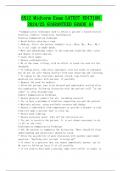Exam (elaborations)
6512 Midterm Exam LATEST EDITION 2024/25 GUARANTEED GRADE A+
- Course
- Institution
·Communication techniques used to obtain a patient's health history Courtesy, Comfort, Connection, Confirmation Courtesy Communication Technique • Knock before entering a room. • Address, first, the patient formally (e.g., Miss, Ms., Mrs., Mr.) It is all right to shake hands. • Meet and...
[Show more]



